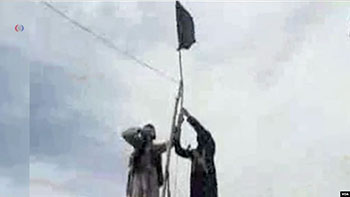By Jeff Seldin
The collapse of the Islamic State's self-declared caliphate in Syria and Iraq is doing little to slow down the terror group's branch in Afghanistan.
Newly unclassified intelligence suggests IS-Khorasan, as the group is known, is growing both in numbers and ambition, now boasting as many as 5,000 fighters — nearly five times as many as estimates from last year — while turning its focus to bigger and more spectacular attacks.

Members of the IS-Khorasan group mount a flag in a tribal region of Afghanistan, Nov. 2, 2015. (Photo: VOA)
Military officials say the numbers, shared by U.S. Forces-Afghanistan for the latest quarterly report by the Lead Inspector General for Operation Freedom Sentinel, issued Tuesday, are "low confidence" estimates but that IS-Khorasan has fighters in Kabul, as well as in Nangarhar and Kunar provinces and in other parts of northeastern Afghanistan.
More worrisome, according to defense intelligence officials, is that the terror group has been gaining ground, both against the Afghan government and the Taliban, expanding the amount of territory under its control in Kunar province since the start of the year.
It also appears IS-Khorasan has managed to gain a toe-hold in other areas. The assessment finds it is "highly likely" IS has smaller cells operating in parts of Afghanistan under either government or Taliban control.
"We're very concerned about their capability and trajectory," Col. Dave Butler, the spokesman for U.S. Forces-Afghanistan, told VOA. "IS-K has made it clear that they aspire to attack the United States and our allies."
The current state of IS in Afghanistan would appear to represent a remarkable turnaround from the terror group's fortunes in April 2017, when the U.S. dropped the largest non-nuclear bomb in the U.S. arsenal, a GBU-43 Massive Ordnance Air Blast, on an IS cave and tunnel system in Nangarhar province.
A series of subsequent U.S. strikes killed the then IS-Khorasan emir and his replacement, and cut the estimated number of fighters from 3,000 to 600.
As recently as late last year, top U.S. military officials insisted IS-Khorasan was being kept in check.
"ISIS-K is not growing," Gen. John Nicholson, the outgoing commander of U.S. Forces-Afghanistan, said in September before handing over the command to Gen. Scott Miller.
Yet despite losing key leaders and suffering constant setbacks on the battlefield, IS-Khorasan found a way to maintain its numbers, successfully recruiting disgruntled Taliban fighters as well as jihadis from further afield.
Afghan officials have likewise warned that IS-Khorasan has benefited from surges of thousands of foreign fighters from Pakistan and Uzbekistan, plus the inflow of hundreds of IS fighters fleeing from Syria.
But increasingly, many of IS-Khorasan's recruits are local, with fewer coming from the ranks of disgruntled Taliban fighters. And the group has even taken a page out of IS core's playbook, targeting young men seeking economic opportunity.
"IS does a lot of recruiting in Afghanistan and the region attempting to enlist disaffected youth and even tech-savvy young people looking for an alternative," Butler said.
The U.S. and Afghanistan are not the only countries voicing concern about the growing IS-Khorasan presence.
Russia's top intelligence official, FSB chief Alexander Bortnikov, on Tuesday warned that 5,000 IS foreign fighters, many of whom have fought in Syria, were massing along Afghanistan's northern border, potentially threatening former Soviet states in the region.
Bortnikov made the comments while visiting Tajikistan, which has blamed a deadly May 19 riot at one of its high-security prisons on IS followers who were being held there.
Many Western intelligence officials and analysts have long been skeptical of Russia's claims when it comes to IS in Afghanistan, noting Moscow is prone to inflate numbers to serve its own interests in the region.



